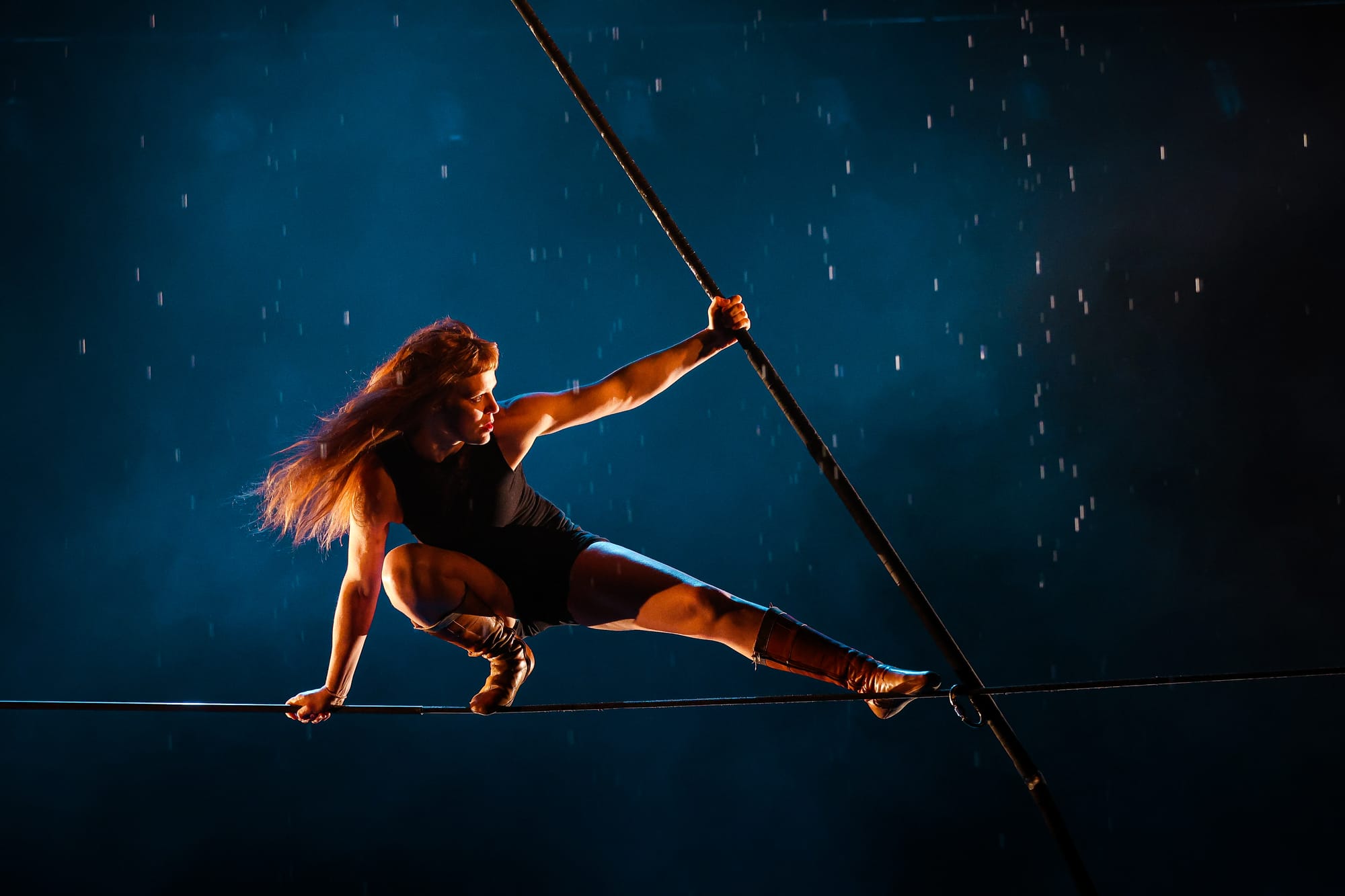When circus meets video games

This article is part of the “inter-magazine Circus Festival project” which is a collaboration between the UP – Circus & Performing Arts Festival, the Université Libre de Bruxelles and five international circus magazines, Around About Circus, Malabart, Juggling Magazine, StageLync, and Dynamo Magazine, all part of the INCAM network. Students at Université Libre de Bruxelles share their thoughts on current stage and circus performances. Their diverse backgrounds—ranging from literature, journalism, and acting, to cultural studies—bring unique perspectives, whether familiar with the art form or newcomers. They are united by a curiosity for performing arts, which led them to the MA Arts du spectacle program, offering exposure to various art forms, including the circus. As part of the Circus|Studies, an interdisciplinary and international research project led by Dr. Franziska Trapp, theatre students explore circus dramaturgy, collaborate with emerging artists, and engage in performance analysis and critique. Their experiences culminate in MA theses or articles like the following.
Five women, two musicians, three circus performers, a net, a wire, a gyratory wheel and a desire to do battle. That is what you could find in Brussels last March with the company Les filles du renard pâle and their show Révolte ou Tentatives de l'échec.
Femininity on stage is one of the company's trademarks, even in its name. It is emphasised through various scenic and dramaturgical elements. It can be seen in the costumes, the voices, the bodies and the movements. Taken together these elements form a dramaturgy of feminine revolt, strong and willing to fight. At the same time, all these elements exacerbate this femininity, bringing it to the fore, and showing it for us to see, feel and experience. It's a total sensory experience. Clothes that are close to the body emphasise it, constantly reminding us of femininity and feminine attributes.

This emphasis is a deliberate theatricality that accentuates the artists' actions and movements so that they can be seen as feminine in all their strength and power. This exaggerated theatricality, which seeks to present fiction as reality, is one of the characteristics of video games. In video games, players are often put in a position where they become the character, which generally results in them identifying with the protagonist they are playing. The player's gaze plays an important role in exposing the character to his or her environment but also in the player's perception of their own reality.
Female characters, who according to studies are often played by men, are frequently hypersexualised, with sexy, body-hugging clothes that rip during battle against particularly strong enemies, as is the case in Bayonetta - an urban fantasy action-adventure whose main character is a witch with the eponymous name, armed with two pistols, weapons strapped to her high heels, and sporting long black hair that can be transformed into a lethal weapon—a sort of visual reward for the male player who has successfully completed the difficult quest.
This element raises the following question: what kind of intertextuality is used in Les filles du renard pâle in relation to female video game characters? Let's look at each element separately.
Firstly, the costumes. Even if they are not particularly low-cut, they fit close to the body and show off the shapes of the performers on stage. With their muscular circus bodies, the clothes they wear refer to the femininity of the characters in the games. Without exaggerating the features with their outfits, the artists manage to show a form of eroticism that we can consider to be specific to women. They have their own way of looking at their bodies and how to make them sexy. This contrasts with video games where—unlike the artists of Les filles du renard pâle—the creators and players are mostly men.
While the world of video games is evolving and women are increasingly being included in the creative process and as a target audience, some games are created with men as the target audience, as in Dead or Alive, a fighting game in which the female characters are over-sexualised and there's even a Swimsuit mode where the characters are in swimming costumes.

This over-sexualisation can even be seen on the game's cover. Female characters are often stereotyped as voluptuously curvaceous, "perfect" women from a male perspective. The female characters do not represent reality. And while the male body in games is also virilised, this virilisation does not contribute to sexualisation to the same extent as it does for female characters. The artists' view of these female characters is therefore an interesting reflection because it is different from the reality they present on stage.

Secondly, movement plays a major role in the perception of femininity. While female characters in video games also have powerful actions, these are nonetheless gentle or softened by feminine markers. In Bayonetta, for example, the heroine opens doors by blowing a kiss accompanied by a swarm of hearts, and her blood in battle has been replaced by flower petals. These two very simple elements affirm the femininity sought by the game designers.
In Révolte ou Tentatives de l'échec, the artists have no such artifices. Their power and physical strength are brought to the fore and are the main elements of each movement. The faces are noble and imbued with the strength and power that the show seeks to affirm. They are also reaffirmed in the risk-taking that is the main and distinctive ingredient of circus performances.

This risk-taking can be compared with the danger faced by adventure video game characters such as Lara Croft, the iconic character in the Tomb Raider series. Based on the very famous Indiana Jones, but feminised and Britishised, the archaeologist Lara Croft sets off on an adventure to find the truth about the world around her. She evolves in a 3D world similar to our own (Greece, Egypt, Italy). In her adventures, she sometimes has to jump from great heights, having to survive in a hostile environment.

There's a parallel to be drawn with the start of the show, where two of the circus artists arrive at the top of the stage, hanging from bouncing ropes and landing on a vertical net. In a game of "Try and catch my hand!", the performers have to survive the vacuum. They want to help each other, but they can’t. They miss each other by a whisker and have to start swinging again to land in the net, in the safe zone.
Adventurous, they take risks to show their strength. Like Lara Croft, who has to be powerful to achieve her goals, the artists want to prove to the audience, and above all to themselves, that they can do it, that they will stand up to the test and demonstrate the full power of their bodies. In this way, they are proving to everyone that the rebellion they want to see will happen and that they will do it, no matter what obstacles are thrown their way.

This emphasis on video games is also reflected in a second scene: a fight between two of the artists, each tied to a bouncing rope, set to music reminiscent of video games such as StreetFighter. The movements are very reminiscent of this fighting game. The principle is very simple: each player fights with a character and launches attacks against his opponent, according to his possible combinations of attacks, until the opponent's life bar is empty. The attacks are of varying degrees of power and cause varying amounts of damage.
In Révolte ou tentatives de l'échec, the two artists throw themselves at each other, held back by the bouncing ropes, trying to defeat their opponent. Just like in Streetfighter, their exchange intensifies as they go along. They even move away from the front of the stage and the floor where they started, to reach the tightrope via the balance pole.

This move intensifies the fight, as they use the balance pole to make the scene more impressive and risky. Unlike the game, there is no winner here. The solitary fight becomes a common fight, with a common cause. We come together to fight and develop this feminine strength. Each time, the element that comes to the fore and that can be linked to video games ends in a pooling of forces, a mutual aid, and a reflection on the common feminine strength.
However, there's another element that we haven't developed, even though it was mentioned at the beginning of the article: the gyratory wheel. This is located at the back of the stage. With no direct interaction, the artist inside knows what's going on around it and accentuates the actions through its circular and infinite movement. The spinning wheel is reminiscent of everyday life, the cycle of life in reality or in games.

In games, characters can live again and again, and players can restart games and continue to develop their characters and their skills. Of course, artists here have no right to make mistakes, which can be fatal to them because the risks they take are real and necessary. But the loop is there, in the background, all the time, reminding us that we can fight, that we can become partners, that we can succeed, but that there will always be a new battle ahead of us.
The intertextuality between the show and video games is therefore brought to life through a female perspective. By appropriating the characteristics of certain games, Les filles du renard pâle put their own perspective on the female characters in these games through their costumes, their actions, and their circus skills. The latter are powerful and demonstrate great physical and mental strength, but also a certain feminine delicacy, qualities that can be found in Bayonetta or Lara Croft.

